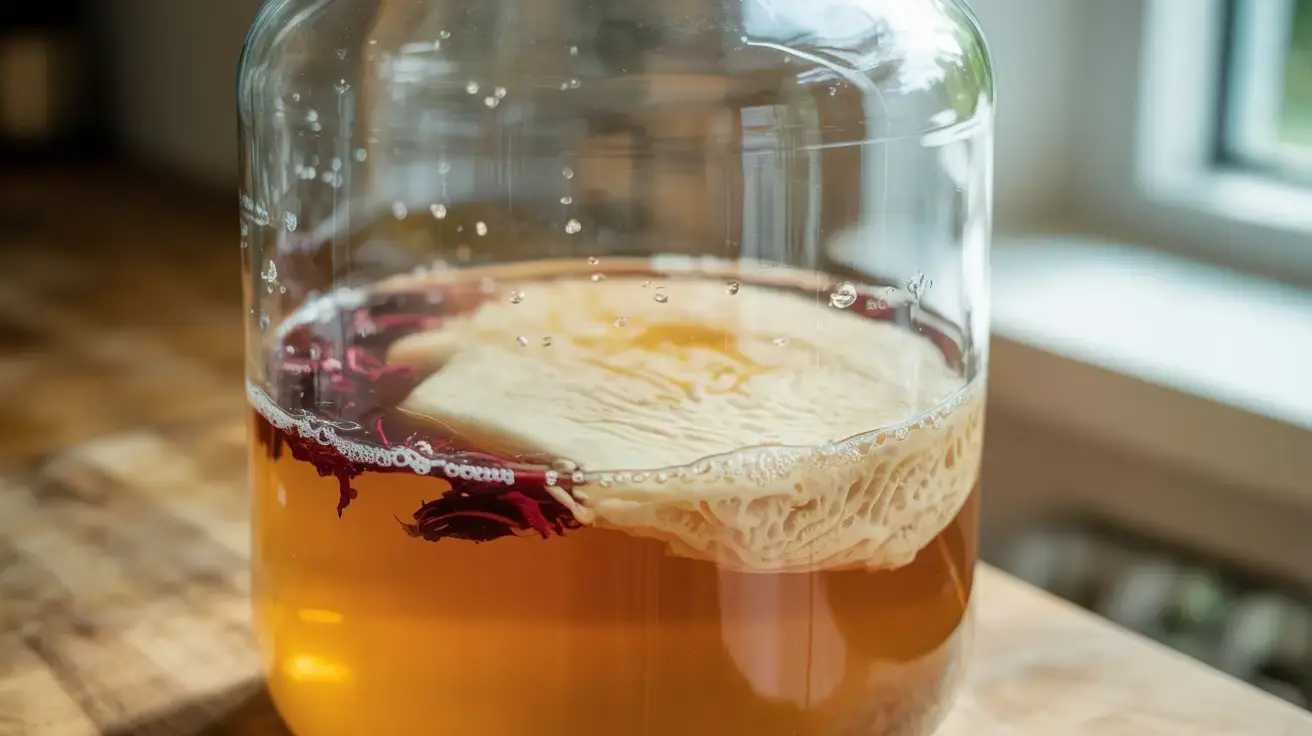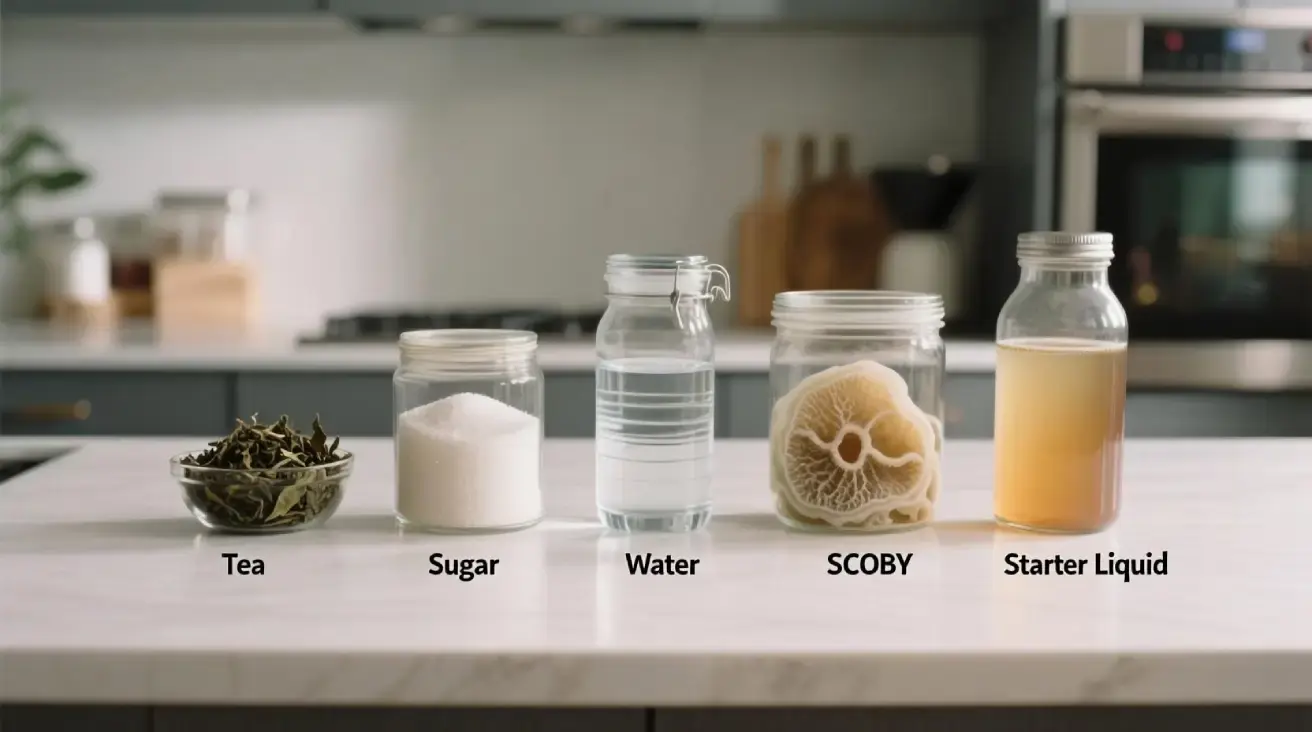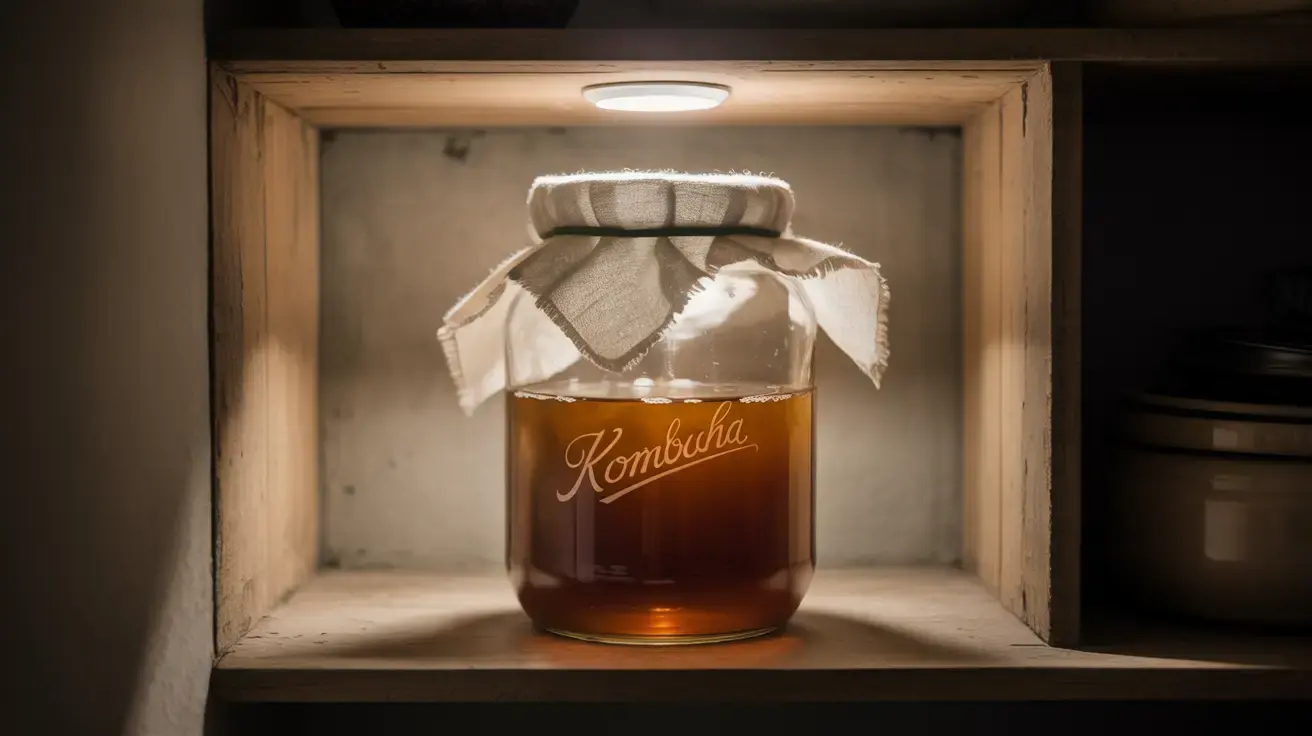Kombucha is a fermented beverage of Asian origin, whose history dates back more than 2,000 years, particularly in China where it was nicknamed "the elixir of immortal life." This drink results from the fermentation of sweet tea using a symbiotic culture of bacteria and yeast, called SCOBY (Symbiotic Culture Of Bacteria and Yeast) or "mother of kombucha."

Kombucha tea's popularity stems from the interest in fermented foods and their potential probiotic benefits. Its ease of preparation attracts many DIY enthusiasts, who appreciate creating a personalized drink at a lower cost. For professionals or those looking to distribute quality products, Kabir is an official TEAZEN Halal wholesale kombucha supplier for Europe.
This beginner's guide to kombucha will guide you through the discovery of this unique beverage, characterized by its tangy taste and fizzy texture. Transforming sweet tea into kombucha involves aerobic fermentation, during which the microorganisms in the SCOBY consume the sugar to produce organic acids, vitamins, and enzymes, giving the beverage its distinctive properties.
The beauty of kombucha lies in its versatility: once you've mastered the basic technique, the flavoring possibilities are endless, allowing you to explore a rich palette of flavors ranging from fruity to spicy or floral notes. You can experiment with different types of tea, herbs, spices, and fruits to create unique flavors.
Having explored the essence of kombucha, let's now look at the potential benefits this ancient beverage can offer your health.
The Health Benefits of Kombucha
The potential health benefits of kombucha are generating scientific interest, although research remains limited. This fermented beverage is notable for its richness in kombucha probiotics, beneficial microorganisms that contribute to a balanced gut flora.
The probiotic aspect of health kombucha is its major asset for digestive health. The lactic acid bacteria and yeast present in the beverage can promote the diversity of the intestinal microbiome, a crucial element for optimal digestion and efficient nutrient absorption. A balanced digestive system directly influences the immune system, since 60 to 80% of our immune cells are concentrated in the intestine. Thus, regular consumption of kombucha could help strengthen the body's natural defenses.
Kombucha's antioxidant properties come primarily from the tea used in its preparation. Green and black tea, rich in polyphenols, impart their beneficial compounds to the fermented beverage. These antioxidants can help neutralize free radicals, unstable molecules that can damage cells and contribute to premature aging. By consuming kombucha, you indirectly benefit from the antioxidant properties of tea.
Kombucha fermentation also generates beneficial organic acids, including acetic acid and glucuronic acid. Acetic acid has natural antimicrobial properties, while glucuronic acid can support liver detoxification processes. These compounds help create a intestinal environment that favors good bacteria while discouraging the growth of pathogenic microorganisms. The combined action of these organic acids contributes to the balance of the intestinal ecosystem.
Kombucha's nutritional profile reveals the presence of B vitamins, essential for energy metabolism and nervous system function. Vitamin C, although in modest amounts, contributes to immune support and collagen synthesis. Trace minerals and amino acids complete this nutritional picture, making kombucha an interesting functional beverage. It's important to note that the nutritional composition may vary depending on the type of tea used and the fermentation time.
However, realistic expectations should be maintained regarding the benefits of kombucha. This beverage is not a miracle cure, but rather a tasty addition to a balanced diet and healthy lifestyle. Moderate consumption, generally recommended between 100 and 200 ml per day, allows you to enjoy its potential benefits without risking the adverse effects of excessive organic acid consumption. As with any fermented food, it is advisable to start with small amounts to assess tolerance.
Now that we've explored the potential benefits of kombucha, let's take a look at the ingredients and equipment needed to start making it at home.
Ingredients and Equipment Needed to Make Homemade Kombucha
Homemade kombucha requires specific ingredients and the right equipment to ensure successful and safe fermentation. The quality of these elements directly influences the final taste and health of your kombucha culture. Proper equipment facilitates the process and minimizes the risk of contamination.

The essential ingredients include, first and foremost, quality tea, the fundamental building block of your kombucha. Black tea provides the most complete nutrients to nourish the kombucha mother, while green tea provides additional antioxidants. A blend of the two creates an optimal balance. It's essential to avoid teas flavored with essential oils or artificial flavors during the initial fermentation, as these additives can damage or kill your kombucha mushroom. Opt for organic teas to avoid pesticides.
Sugar is the fuel for fermentation. Refined white sugar or golden cane sugar work perfectly, being easily metabolized by the yeast and bacteria in the SCOBY. Avoid honey, artificial sweeteners, or overly processed sugars, which can disrupt the microbial balance of your culture. Sugar is essential to the process, but it is largely consumed by the microorganisms during fermentation.
The water used must be of optimal quality, ideally filtered or spring water, to remove chlorine and other chemicals that can inhibit fermentation. Chlorinated tap water can literally poison your kombucha mother, compromising the entire preparation. Pure water ensures a healthy environment for fermentation.
The kombucha mother, or SCOBY, is the heart of your brew. This gelatinous culture, sometimes uninviting in appearance, houses the microbial ecosystem responsible for magically transforming sweet tea into kombucha. Along with its starter liquid (already fermented kombucha), it provides the acidification needed to kick-start a new fermentation. The SCOBY is a living organism that requires proper care.
Regarding equipment, choose a wide-mouthed glass fermentation jar with a capacity of at least one liter. Glass remains neutral and does not interact with the acidity of the kombucha, unlike metal, which can be corrosive. The wide opening facilitates the oxygenation necessary for aerobic fermentation. A transparent jar allows you to visually monitor the fermentation process.
A fine-mesh fabric, such as cheesecloth or a clean cloth, can protect your fermentation from dust and insects while maintaining essential gas exchange. Secure it securely with a sturdy rubber band to prevent contamination. The fabric should be breathable to allow air to circulate.
For the secondary fermentation, invest in pressure-resistant bottles specifically designed for carbonated beverages. Reused beer bottles or bottles with a flip-top closure are ideal, unlike decorative bottles, which risk exploding under the pressure of the carbon dioxide produced. Safety is paramount during the secondary fermentation.
Once you're equipped, let's move on to the practical part: the detailed recipe for preparing your own kombucha, step by step.
Step-by-step recipe for making kombucha
Kombucha recipe follows a methodical process that, once mastered, becomes a relaxing and rewarding ritual. This detailed recipe will guide you through each crucial step, from the initial tea preparation to enjoying your first homemade creation. With a little practice, you'll become a kombucha expert.
Start by preparing your base tea by bringing a liter of filtered water to a boil. Remove from heat and add 8 grams of tea (about 4 tea bags or 4 teaspoons of loose tea), choosing a blend of black and green tea for the best nutritional profile. Let it steep for 15 minutes to extract the maximum nutrients and tannins, which are essential for the health of your kombucha mother. A longer steep time results in a more nutrient-dense tea.
Remove the tea and stir in 70 grams of white sugar, stirring until completely dissolved. This sweetening step is crucial: the sugar isn't used to sweeten your final beverage, but rather serves as the primary food for the microorganisms during kombucha fermentation. Allow the sweetened tea to cool completely to room temperature, an absolutely essential step to preserve the vitality of your culture. High temperatures can damage the SCOBY.
Once the tea has cooled, pour it into your glass fermentation jar. Add 100 ml of starter liquid (already fermented kombucha), which will acidify the medium and create a favorable environment for your SCOBY while discouraging unwanted microorganisms. Gently place your kombucha mother on the surface of the liquid. Don't worry if it sinks initially; it will rise naturally or a new film will form on the surface. Starter liquid is essential for successful fermentation.
Cover the jar with your fine-mesh fabric, secured with an elastic band, creating a protective barrier while allowing for the necessary gas exchange. Place your fermentation in a stable location at room temperature (ideally 22-24°C), away from direct light and vibrations. A stable environment promotes regular fermentation.
Patience then becomes your best ally. Kombucha's primary brew typically lasts 7 to 14 days, depending on room temperature and your taste preferences. Taste your kombucha starting on the seventh day by gently taking a sample with a wooden or plastic spoon. The taste evolves from a sweet tea to a tangy, slightly sparkling beverage. Regular tasting allows you to monitor the evolution of the flavor.
When you're happy with the sweet-tart balance, your first fermentation is complete. Reserve your kombucha mother along with 200 ml of fermented kombucha in a clean container for your next batch. The remainder can be consumed immediately or undergo a second fermentation to develop more flavor and fizz. Saving some of the fermented kombucha ensures continuity of production.
To delve deeper into the process, let's explore the first fermentation in more detail, a crucial step in creating your kombucha.
First Fermentation - The Basic Process
The first kombucha fermentation is the heart of the kombucha creation process, transforming a simple sweet tea into a complex and vibrant beverage. This phase, which lasts from 7 to 30 days, depends on multiple environmental and flavor factors that influence the final result. It is during this stage that the SCOBY works to transform the sweet tea.

During this crucial period, the kombucha mother orchestrates a fascinating biochemical symphony. The yeasts in the SCOBY begin by breaking down the sugar into alcohol and carbon dioxide, creating a slightly alcoholic environment. Simultaneously, the acetic acid bacteria convert this alcohol into organic acids, primarily acetic acid, giving kombucha its distinctive tart character. It is the balance between these two actions that gives kombucha its unique taste.
Temperature plays a decisive role in the speed and quality of fermentation. An optimal temperature between 22 and 24°C promotes balanced microbial activity, while a lower temperature slows the process and excessive temperatures can unbalance the culture or encourage the growth of unwanted microorganisms. It is therefore important to monitor the ambient temperature.
Visual observation of your fermentation reveals valuable clues about its progress. A new skin may form on the surface, a sign of an active and healthy culture. Brown filaments or deposits at the bottom of the container are normal and indicate yeast activity. Only the appearance of colored mold (green, black, or blue) requires immediate cessation of the process. Vigilance is required to avoid any contamination.
The taste gradually evolves from a sweet tea to an increasingly tart beverage. This taste transformation allows you to determine the optimal time to stop fermentation according to your personal preferences. Young kombucha retains a residual sweetness, while prolonged fermentation develops a more pronounced acidity and complex winey notes. Taste is the best indicator of the end of the first fermentation.
After this initial stage, the second fermentation offers an opportunity to enrich your kombucha with personalized flavors and increased fizz.
Second fermentation - Aromatization and sparkling
The second fermentation represents the creative stage of kombucha preparation, allowing you to personalize the kombucha's flavor and intensify the drink's natural fizz. This anaerobic phase, carried out in hermetically sealed bottles, transforms your basic kombucha into a unique and refreshing creation. It's time to let your imagination run wild.
After carefully removing your kombucha mother and reserving the starter liquid for your next batch, strain your kombucha through a fine cloth to remove any residue. This step, while optional, improves the clarity and final texture of your beverage. A strained kombucha is more enjoyable to drink.
Flavoring opens up a world of creative possibilities. Fresh or dried fruit adds natural flavors and residual sugars that fuel the secondary fermentation. Aim for about 10 to 15% of the total volume as fruit for a balanced flavor. Pure fruit juices, spices like ginger or cinnamon, and even fresh herbs like mint create unique flavor profiles. Feel free to experiment with different combinations. For those looking for convenience without compromising taste or benefits, options like TEAZEN Kombucha Berry Flavor, the TEAZEN Kombucha Peach, or the TEAZEN Kombucha Pineapple offer a quick and delicious solution. Citrus lovers will also appreciate the TEAZEN Kombucha Citron (Yuzu) and the TEAZEN Kombucha Lemon Classiqueall available in instant, sugar-free and low-calorie formats.
Bottling requires special attention to safety. Use only pressure-resistant bottles, leaving a 2-3 cm gap at the top of each bottle to allow for gas expansion. This precaution prevents dangerous overpressures that could cause the containers to burst. Safety is paramount during this step.
The secondary fermentation generally lasts from 1 to 4 days at room temperature. Monitor the pressure daily by briefly opening a sample bottle. When you are satisfied with the level of fizz, immediately transfer all bottles to the refrigerator to stop fermentation and maintain optimal carbonation. Pressure control is essential to avoid accidents.
This final step in kombucha preparation rewards your patience with a personalized drink, combining the probiotic benefits of traditional kombucha with the flavors of your choice, creating a healthy and tasty alternative to commercial sodas. This allows you to create a unique drink that suits your tastes.

Once your kombucha is flavored and sparkling, it is essential to know the best storage and maintenance practices to maintain its quality and ensure the longevity of your culture.
Storing and maintaining your kombucha
Proper storage of your kombucha and meticulous care of your kombucha mother ensure the longevity of your home production and the consistent quality of your future creations. These essential practices transform your hobby into a sustainable source of homemade probiotic drinks. Proper maintenance ensures continuous, high-quality production.
Once your first fermentation is complete, storing finished kombucha requires immediate refrigeration to drastically slow microbial activity. At refrigerated temperatures, your beverage retains its flavor and probiotic qualities for several weeks or even months, while continuing a very slow fermentation that can slightly intensify acidity over time. Refrigeration is the key to proper storage.
Maintaining your kombucha mother is the most crucial aspect of your ongoing production. This living culture thrives on regular use, ideally every 2 to 4 weeks. Between production runs, store your SCOBY in a "SCOBY hotel": a glass container containing your culture bathed in fermented kombucha and fresh sweet tea, covered with a breathable fabric. A SCOBY hotel helps keep your culture healthy.
If you're planning an extended break in your production, you have several options. Refrigeration significantly slows down your culture's activity, allowing it to be stored for several months with minimal maintenance. Alternatively, dehydrating your kombucha mother on a non-metallic rack creates a long-term backup, which can be reactivated by rehydrating it in sweet tea. Dehydration is a solution for extended absences.
Regularly monitor the health of your culture. A healthy kombucha mother is beige to brown in color, firm but pliable in texture, and may develop normal brown filaments. Only the appearance of colored mold (green, blue, black) with a fuzzy appearance requires complete removal of the culture and restarting with a new strain. Regular monitoring allows for early detection of any problems.
To avoid common mistakes and ensure the success of your first productions, here are some essential tips to follow.
Common Mistakes to Avoid for Beginners
Mastering homemade kombucha is a gradual process, and some common mistakes can hamper your first attempts. This beginner's guide to kombucha identifies common pitfalls to help you avoid disappointment and maximize your chances of success from your first attempts. Avoiding these mistakes will increase your chances of success.
Hygiene is the absolute foundation of successful fermentation. Neglect this crucial step, and you risk contaminating your precious culture with pathogenic microorganisms. Always sterilize all your utensils with boiling water or a 70% alcohol solution, wash your hands thoroughly before handling anything, and maintain a clean work environment. Impeccable hygiene is essential to avoid contamination.
Using metal utensils is a classic mistake with potentially disastrous consequences. Prolonged contact between metal and the acidity of kombucha can create harmful chemical reactions in your culture and alter the taste of your beverage. Always use wood, glass, or food-grade plastic for all your handling and measuring tools. Metal should be avoided to avoid any chemical reactions.
The choice of tea directly influences the health of your kombucha mother. Teas flavored with essential oils, caffeine-free herbal teas, or blends containing artificial additives can weaken or kill your culture. Follow the golden rule: pure black tea, green tea, or white tea to optimally nourish your SCOBY, reserving aromatic experiments for the secondary fermentation. A quality tea is essential for the health of the SCOBY.
Temperature management often reveals itself to inexperienced beginners. Too low a temperature (below 18°C) dangerously slows fermentation, promoting mold growth, while excessive heat (above 30°C) can unbalance your culture. Maintain a stable temperature between 20 and 25°C, avoiding sudden changes and direct heat sources. A stable temperature is crucial for successful fermentation.
Exposure to direct sunlight gradually damages your kombucha mother and can alter the nutritional properties of your beverage. Choose a bright but indirect location that is stable and free from drafts that could disrupt fermentation or introduce contaminants. Proper placement is important for the health of the SCOBY and the quality of the kombucha.
Secondary fermentation presents its own pitfalls, including bottle pressure management. Overfilling or fermenting for too long can create dangerous excess pressure, turning your bottles into potential projectiles. Respect the recommended headspace and monitor carbonation daily. Safety is paramount during secondary fermentation.
Finally, impatience is probably the most common mistake among novices. Kombucha fermentation follows its own pace, influenced by multiple environmental factors. Resist the temptation to over-manipulate your culture or rush the process: patience always rewards novice kombucha brewers with exceptional results. Patience is an essential virtue for successful kombucha.